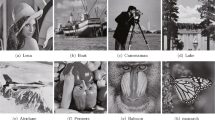Abstract
In this paper we proposed a new de-noising technique based on combination of isotropic diffusion model, anisotropic diffusion (PM) model, and total variation model. The proposed model is able to be adaptive in each region depending on the information of the image. More precisely, the model performs more diffusion in the flat areas of the image, and less diffusion in the edges of the image. And so we can get rid of the noise, and preserve the edges of the image simultaneously. To verify that, we did several experiments, which showed that our algorithm is the best method for edge preserving and noise removing, compared with the isotropic diffusion, anisotropic diffusion, and total variation methods.





Similar content being viewed by others
References
Andreu F, Mazón JM, Moll JS (2005) The total variation flow with nonlinear boundary conditions. Asymptotic Anal 43(1–2):9–46
Aubert G, Kornprobst P (2006) Mathematical Problems in Image Processing PDEs and the Calculus of Variations, 2nd edn. Springer, New York
Beck A, Teboulle M (2009) Fast gradient-based algorithms for constrained total variation image denoising and deblurring problems. IEEE T Image Process 18(11):2419–2434
Bijaoui A (2002) wavelets, gaussian mixtures and wiener filtering. Signal Process 82(4):709–712
Catté F, Lions P-L, Morel J-M, Coll T (1992) Image selective smoothing and edge detection by nonlinear diffusion. SIAM J Numer Anal 29(1):182–193
Chang SG, Yu B, Vetterli M (2000) Spatially adaptive wavelet thresholding with context modeling for image denoising. IEEE T Image Process 9(9):1522–1531
Chatterjee P, Milanfar P (2010) Is denoising dead? IEEE T Image Process 19(4):895–911
Gallouët T, Herbin R (2004) Convergence of linear finite elements for diffusion equations with measure data. Comptes Rendus Mathematique 338(1):81–84
Garamendi JF, Gaspar FJ, Malpica N, Schiavi E (2013) Box relaxation schemes in staggered discretizations for the dual formulation of total variation minimization. IEEE T Image Process 22(5):2030–2043
Gilboa G, Sochen N, Zeevi YY (2002) Forward-and-backward diffusion processes for adaptive image enhancement and denoising. IEEE T Image Process 11(7):689–703
Guo Z, Sun J, Zhang D, Wu B (2012) Adaptive Perona-Malik model based on the variable exponent for image denoising. IEEE T Image Process 21(3):958–967
Kannan K, Perumal SA, Arulmozhi K (2010) Optimal decomposition level of discrete, stationary and dual tree complex wavelet transform for pixel based fusion of multi-focused Images. Serbian J Elec Eng 7(1):81–93
Li F, Gao F, Cai N (2011) A new algorithm for removing salt and pepper noise from images. J Inform Comput Sci 8(16):3819–3825
Liu J, Gao F, Li Z (2011) A model of image denoising based on partial differential equations. The Proceedings of IEEE International Conference on Multimedia Technology (ICMT), China, 26–28 July 2011. pp 1892–1896
Lysaker M, Lundervold A, Tai X-C (2003) Noise removalusing fourth-order partial differential equation with application to medical magnetic resonance images in space and time. IEEE T Image Process 12(12):1579–1590
Lysaker M, Osher S, Tai X-C (2004) Noise removalusing smoothed normals and surface fitting. IEEE T Image Process 13(10):1345–1357
Lysaker M, Tai X-C (2006) Iterative image restoration combining total variation minimization and a second-order functional. Int J Comput Vision 66(1):5–18
Mendrik AM, Vonken EJ, Rutten A, Viergever MA, Ginneken B (2009) Noise reduction in computed tomography scans using 3-D anisotropic hybrid diffusion with continuous switch. IEEE T Med Imaging 28(10):1585–1594
Perona P, Malik J (1987) Scale space and edge detection using anisotropic diffusion. Proc. IEEE Comp. Soc. Workshop on Computer Vision (Miami Beach, Nov. 30–Dec. 2, 1987), IEEE Computer Society Press. Washington, pp 16–22
Perona P, Malik J (1988) A network for multiscale image segmentation, Proc. IEEE Int. Symp. Circuits and Systems (ISCAS-88, Espoo, June 7–9 1988), pp 2565–2568
Perona P, Malik J (1990) Scale space and edge detection using anisotropic diffusion. IEEE T Pattern Anal 12(7):629–639
Portilla J, Strela V, Wainwright MJ, Simoncelli EP (2003) Image denoising using scale mixtures of gaussians in the wavelet domain. IEEE T Image Process 12(11):1338–1351
Ram I, Elad M, Cohen I (2011) Generalized Ttree-based wavelet transform. IEEE T Signal Proces 59(9):4199–4209
Rudin L, Osher S, Fatemi E (1992) Nonlinear total variation based noise removal algorithms. Phisica D 60(1–4):259–268
Scherzer O, Weickert J (2000) Relations between regularization and diffusion filter. J Math Imaging Vis 12(1):43–63
Sorzanoa COS, Ortiza E, Lóezc M, Rodrigod J (2006) Improved bayesian image denoising based on wavelets with applications to electron microscopy. Pattern Recogn 39(6):1205–1213
Tikhonov AN, Arsenin VY (1977) Solutions of Ill-Posed problem. Winston and Sons, Washington, D.C.
Wang Z, Bovik AC, Sheikh HR, Simoncelli EP (2004) Image quality assessment: from error visibility to structural similarity. IEEE T Image Process 13(4):1–14
Weickert J (1998) Anisotropic Diffusion in Image Processing, University of Copenhagen Denmark Press
Witkin AP (1983) Scale-space filtering. 8th International Joint Conference on Artificial Intelligence, vol 2. Karlsruhe, West Germany, pp 1019–1022
Yahya AA, Tan J (2012) A novel partial differential equation method based on image features and its applications in denoising. In: The Proceedings of the Fourth IEEE International Conference on Digital Home (ICDH), Guangzhou, China, 23–25 Nov 2012, pp 46–51
Zhang X, Wang R, Jiao LC (2011) Partial differential equation model method based on image feature for denoising. In: The Proceedings of IEEE International Workshop on Multi-Platform/Multi-Sensor Remote Sensing and Mapping (M2RSM), China, pp 1–4
Author information
Authors and Affiliations
Corresponding author
Additional information
This work is supported by the NSFC-Guangdong Joint Foundation (Key Project) under Grant No. U1135003 and the National Natural Science Foundation of China under Grant No. 61070227.
Rights and permissions
About this article
Cite this article
Yahya, A.A., Tan, J. & Hu, M. A blending method based on partial differential equations for image denoising. Multimed Tools Appl 73, 1843–1862 (2014). https://doi.org/10.1007/s11042-013-1586-6
Published:
Issue Date:
DOI: https://doi.org/10.1007/s11042-013-1586-6




